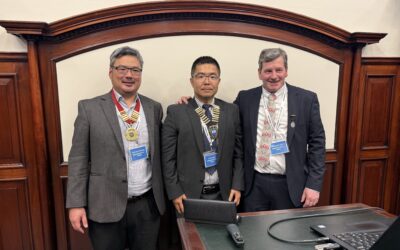The October presentation was given by Anthony Setiadi, Wood Thilsted Partners, on the ongoing challenges in corrosion protection of foundations for offshore wind technologies. This was a well-attended hybrid event, joint with LMS had approximately 60 attendees, split 2/3rds in person and 1/3rd online.
Anthony Setiadi
The offshore wind industry growth is rapidly accelerating as the world is pushing towards renewable energy sources. Wind turbines often need to be installed on foundations which are in aggressive environments that are prone to corrosion if not protected and / or designed with corrosion in mind. There are various offshore wind foundation types, such as, monopiles, jackets, tetrabases, gravity bases and floating structures, often grouped in vast arrays for reasons of economy.
The presentation was primarily focused on monopile foundations and the design considerations that would need to be taken onboard. Monopiles have both internal and external surfaces needing protection. Coating requirements and different cathodic protection systems (i.e. galvanic and ICCP) were discussed for the internal and external of the MP. Anthony stressed that there were challenges regarding positioning of the CP system and installation concerns which needed to be considered along with any simultaneous operations that need to happen offshore during the installation phases, e.g. piling operations that limit placement of anodes on the primary structure.
The main consideration is how the structure would behave with and without corrosion protection, especially the fatigue critical components such as the girth welds. The other consideration would be the site condition which will vary across the different wind farm locations and in some cases, a clustering strategy for varying sets of marine and geological conditions may be needed.
In addition, a corrosion protection plan must be developed and agreed well in advance, which then needs to be followed through to completion, including input to operation and maintenance strategies to ensure that the structure integrity is not compromised throughout design life.
This very interesting presentation was followed by a comprehensive Q&A session. Anthony was then presented with an ICorr pen by Paul Brooks.
The November meeting had unfortunately to be held online only, due to the TFL tube strike. The presentation was given by Roland Anderson of Axess-Corrosion Inc., about new solutions to problems related to intrusive corrosion monitoring systems, and learn about, and evaluate, innovations relating to the safety of these monitoring devices. Roland Anderson has over 20 years’ experience in the Oil & Gas industry focused on internal corrosion monitoring programmes globally, and has developed and established businesses in many locations including the UK, Middle East, Australia, China, and the USA.
![]()
Typical offshore wind monopile foundation (Wood Thilsted).
Roland first looked at some examples of incidents ranging in severity from loss of containment to fatality, in particular a fatality in 2012 which sent shockwaves throughout the industry, and the many operators who had not serviced access systems under line pressure due to risk management concerns, and which was highlighted in an ‘Learning from Incidents Action Alert’ published by Shell in 2012.
Corrosion monitoring devices are designed to be changed out under live process pressure, negating the need for the process to be shutdown, utilising an access system and specialised retrieval equipment. The access systems can be either mechanical or hydraulic, and the systems are also used for the installation of erosion, scale, hydrogen monitoring devices, and chemical injection and sampling hardware.
There was a trend, sparked by the 2012 incident, and fueled by technology companies, to move towards non-intrusive monitors. His company supply, install, and data manage these systems, which provide good value, but when talking about corrosion monitoring, it’s often actually chemical performance monitoring, and this cannot achieve the level of insights required to optimise chemical performance with ultrasonics. Intrusive and non-intrusive sensors are complementary, and the trend towards non-intrusive is driven by the need to convert inspection to monitoring, opposed to replacing one system with another.
Corrosion coupons, the backbone of traditional monitoring systems, at low to moderate corrosion rates, can detect the performance of chemical injection programmes 2 years before inspections. Electrical Resistance (ER) probes are complementary to coupons, and are used to obtain very accurate data over short periods of time to enable chemical injection optimisation. ER probes can also be designed for erosion monitoring.
This table provides examples of the time it takes to detect metal loss.


